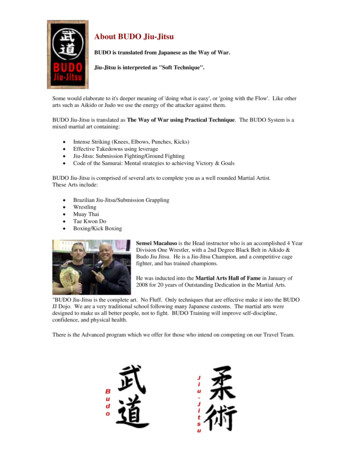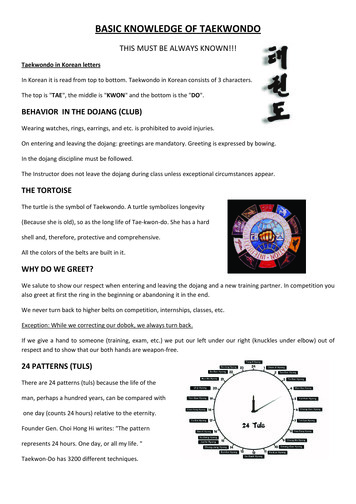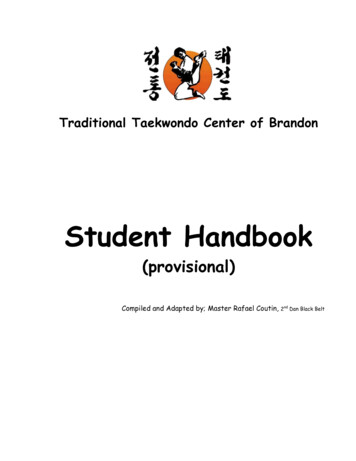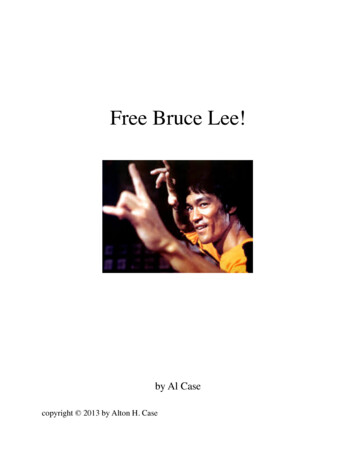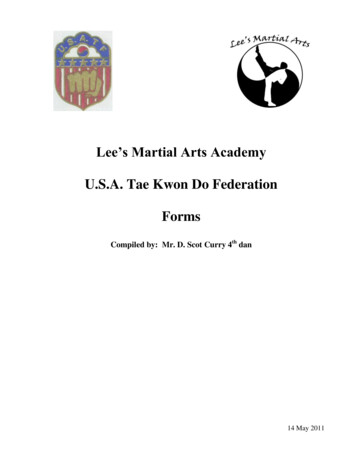
Transcription
Lee’s Martial Arts AcademyU.S.A. Tae Kwon Do FederationFormsCompiled by: Mr. D. Scot Curry 4th dan14 May 2011
Tae Kwon Do Forms Background and DefinitionsThe Lee’s Martial Arts Academy is sanctioned by the U.S.A. Tae Kwon-do Federation, which wasfounded by GrandMaster Lee Kie Duck (GM Duke Lee). GM Lee is a 9th dan in the World Tae Kwondo Federation (WTF). Below is a brief description of the background and definitions of our Academy’sforms. The first forms learned by every student at the Lee’s Martial Arts Academy (Lee’s) are theKicho forms. Kicho can be translated into beginning, basic, or fundamental. There are three Kichoforms.The Kicho Forms. These are the basic forms that all students at Lee’s are required to learn.Kicho Il jang. – (Yellow)Kicho Ee jang. – (Yellow)Kicho Sam jang. – (Orange)The following is taken from http://www.natkd.com/palgawe.htm.The Palgwe forms are one of two options used for color belt gradings in Olympic Tae Kwon-Do. Thesewere the first set of forms the WTF created. The Taegeuk forms are used more often in modernWTF/Olympic curriculums. Many WTF schools teach the Palgwe forms to supplement theircurriculum. The main difference between the Taegeuk forms and the Palgwe forms is that the Palgweforms use more of the deeper traditional stances than the Taeguek forms which use more of the shorterwalking stances.Palgwe Forms (Poomses): Detailed Descriptions and HistoriesWTF uses Poomses for patterns. Poomses originate from the book 'I Ching', a Chinese oracle. The IChing has 64 hexagrams, a combination of two sets of three lines, closed or broken. The sets of threelines are called trigrams. The closed lines represent Yang, the open lines Yin. In the Chinese language,the unity of Yin and Yang is called 'taich'i'. In the Korean language, the unity is called T'ae-guk. Thisexplains the term Poomse Taegeuk. The eight trigrams together are called Pal-gwe as in PoomsePalgwe.Poomse Taegeuk/Palgwe Il Jang -- Heaven (Orange Belt)(South, Father) The first Taegeuk/Palgwe is the beginning of all Poomses. Theassociated trigram represents Yang (heaven, light), therefore, this Poomse should beperformed with the greatness of Heaven.Poomse Taegeuk/Palgwe Ee Jang -- Lake (Green Belt)(South East, Youngest daughter) In the depths of the lake are treasures and mysteries.The movements of this Taegeuk/Palgwe should be performed knowing that man haslimitations, but that we can overcome these limitations. This should lead to a feeling ofjoy, knowing that we can control our future.Poomse Taegeuk/Palgwe Sam Jang -- Fire (Purple Belt)(East, Second daughter) Fire contains a lot of energy. Fire helped man to survive, buton the other hand had some catastrophical results. This form should be performedrhythmically, with some outbursts of energy.Poomse Taegeuk/Palgwe Sa Jang -- Thunder (Purple Belt)(North East, Eldest son) Thunder comes from the sky and is absorbed by the earth.Thunder is one of the most powerful natural forces, circling, gyrating. ThisTaegeuk/Palgwe should be performed with this in mind.1
Poomse Taegeuk/Palgwe Oh Jang -- Wind (Blue Belt)(South West, Eldest daughter) Wind is a gently force, but can sometimes be furious,destroying everything in it's path. Poomse Taegeuk/Palgwe Oh Jang should beperformed like the wind: gently, but knowing the ability of mass destruction with asingle movement.Poomse Taegeuk/Palgwe Yook Jang -- Water (Brown Belt)(West, Second son) Water can move a mountain. The movements of this Poomseshould be performed like water. Sometimes standing still like water in a lake,sometimes thriving as a river.Poomse Taegeuk/Palgwe Chil Jang -- Mountain (Red Belt)(North West, Youngest son) Mountains will always look majestic, no matter the size.This Poomse should be performed with the feeling that all movements are this majesticand deserved to be praised.Poomse Taegeuk/Palgwe Pal Jang -- Earth (Red/Black Belt)(North, Mother) The associated trigram of this Poomse is Yin: the end of thebeginning, the evil part of all that is good. Even in this darkness, there is still somelight. Performing this Taegeuk/Palgwe, one should be aware that this is the lastTaegeuk/Palgwe to be learned, it also is the end of a circle, and therefore it is also thefirst, the second etc.Both Palgwe's and Taegeuk's are numbered from one to eight. For forms described after thispoint, there is no longer a difference between the patterns. The patterns below are taught afterthe Poomse Taegeuks as well as the Poomse Palgwes and are black belt (dan) forms.2
Poomse Koryo – 1st danKoryo (Korea) is the name of an old Korean Dynasty. The people from the Koryo-perioddefeated the Mongolian aggressors. Their spirit is reflected in the movements of the PoomseKoryo. Each movement of this Poomse represents the strength and energy needed to controlthe Mongols. Our version varies slightly from the WTF version. Koryo poomsae symbolizes"seonbae", which means a learned man, who is characterized by a strong martial spirit as wellas a righteous learned man's spirit. The spirit had been inherited through the ages of Koguryo,Palhae and down to Koryo, which is the background of organizing the Koryo poomsae. Thenew techniques appearing in this poomsae are kodeup-chagi, sonnal bakkat-chigi, hansonnalarae-makki, khaljaebi, mureup kkukki, momtong hecho-makki, jumeok pyojeok-jireugi,pyonsonkkeut jeocho-tzireugi, batangson nullo-makki, palkup yop-chagi, mejumeok araepyojeok-chigi, etc, which only black-belts can practice. The junbi-seogi is the tongmilgiwhich requires mental concentration by positioning the hand in between the upper abdomenand the lower abdomen where "sin"(divine) and "jeong"(spirit) converge. The line of poomsaerepresents the Chinese letter which means "seonbae" or "seonbi", a learned man or a man ofvirtue in the Korean language.Poomse Keumgang – 2nd danThe definition of Keumgang is "Too strong to be broken", or "diamond". The movements ofthe Poomse Keumgang are as beautiful as the Keumgang-san (a Korean mountain) and asstrong as Keumgang-seok (diamond). Our version is slightly different. Keumgang (meaningdiamond) has the significance of "hardness" and "ponderosity". The Mt. Keumgang on theKorean peninsula, which is regraded as the center of national spirit, and the "Keumgang yoksa"(Kumgang warrior) as named by Buddha, who represents a mightiest warrior, are thebackground of denominating this poomsae. New techniques introduced in this poomsae arebatangson teokchigi, hansonnal momtong anmakki, Keumgangmakki, santeulmakki, kheundoltzeogi (large hinge), etc., and the hakdariseogi. The poomsae line symbolizes a mountaindisplayed by the Chinese letter. The movements should be powerful and well-balanced so asto befit black-belter's dignity.Poomse TaeBaek – 3rd danThe legendary 'Dangoon' founded a nation in Taebaek, near Korea's biggest mountainBaekdoo. Baekdoo is a symbol for Korea. The definition of Taebaek is "lightness". Everymovement in this Poomse must not only be exact and fast, but with determination andhardness. Our version is slightly different. Taebaek is the name of a mountain with themeaning of "bright mountain", where Tangun, the founder of the nation of Korean people, andthe bright mountain symbolizes sacredness of soul and Tangun's thought of "hongikingan"(humanitarian ideal). There are numerous sites known as Taeback, but Mt. Paektu,which has been typically known as the cradle of Korean people, is the background of namingthe Taebaek poomsae. New techniques introduced in this poomsae are sonnal araehechomakki, sonnal opeojapki (grabbing), japhin sonmokppaegi (pulling out the caught wrist),Keumgang momtong-makki, doltzeogi (hinge), etc. The line of poomsae is like a Chineseletter, which symbolizes the bridge between the Heaven and the earth, signifying human beingsfounded a nation by the Heaven's order. The poomsae movements are largely composed ofmomtongmakki and chigi.3
Poomse Pyongwon – 4th danThe definition of Pyongwon is "stretch, vast plain": big, majestic. ―Pyongwon‖ means a plain whichis a vast stretched-out land. It is the source of life for all the creatures and the field where the humanbeings live their life. The poomsae Pyongwon was based on the idea of peace and struggle resultingfrom the principles of origin and use. The new techniques introduced in this poomsae are palkupollyochigi, olgul kodureo yop-makki, dangkyo teokchigi, meongyechigi, hechosanteulmakki, etc. Thejunbiseogi is the moaseogi wenkyopson (left overlapping hands), which requires concentration offorce in the lower abdomen, the source of body strength, as the land is the beginning and source ofhuman life. The line of poomsae means the origin and transformation of the plain.Poomse Sipjin – 5th danSipjin stands for decimal. This Poomse represents the orderliness of the decimal system. It alsomeans the endless development and growth in a systematic order: stability. The word ―Sipjin‖ wasderived from the thought of 10 longevity, which advocates there are ten creatures of long life, namely,sun, moon, mountain, water, stone, pine tree, herb of eternal youth, tortoise, deer, and crane. There aretwo heavenly bodies, 3 natural resources, two plants, and 3 animals, all giving human beings faith,hope and love. The poomsae Sipjin symbolizes those things. The new techniques introduced in thispoomsae are hwangso-makki, sonbadak kodureo makki, bawimilgi (rock pushing), sonnaldeungmomtong hechomakki, kklyeolligi (lifting up), chetdarijireugi (fork shape jireugi), sonnal otkoreoaraemakki, sonnaldeung momtongmakki, which counts 10. The Chinese letter meaning ten is form ofthe poomsae line, which signifies an infinite numbering of the decimal system and ceaselessdevelopment.Poomse Jitae – 6th danJitae is derived from the meaning of the earth. All things evolve from and return to the earth, the earthis the beginning and the end of life. The word ―Jitae‖ means a man standing on the ground with thetwo feet, looking over the sky. A man on the earth represents the way of struggling for human life,such as kicking, treading and jumping on the ground. Therefore, the poomsae symbolizes variousaspects occurring in the course of human being’s struggle for existence. The new techniquesintroduced in this poomsae are hansonnal olgul-makki, keumgang momtong-jireugi, anpalmokkodureo makki and mejumeok yop pyojeok-chigi only, and the poomsae line signifies a man standingon the earth to spring up toward the heaven.Poomse Cheonwon – 7th danThe word ―Chonkwon‖ means the Heaven's Great Mighty, which is the origin of all the creature anditself the cosmos. Its infinite competence signifies the creation, change and completion. Humanbeings have used the name of Heaven for all principal earthly shapes and meanings because they feltafraid of the Heaven's mighty. Over 9,000 years ago, the founder of the Korean people, ―Chonkwon‖,was meant by the heavenly king. He settled down in the heavenly town as the capital near the heavenlysea and heavenly mountain, where the Han people as the heavenly race gave birth to the properthought and actions from which Taekwondo was originated. The new techniques introduced in thispoomsae are nalgae pyogi (wing opening), sosumjumeok sosumchigi (knuckle protruding fistspringing chigi), hwidullomakki (swinging-makki), hwidullo jabadangkigi (swing and drawing),sonnaldeung wesanteul makki, keumgang yopjireugi, taesan-milgi, etc., and a crouched walkingmanner. The characteristics of movements are large actions and arm actions forming gentle curves,thus symbolizing the greatness of Chonkwon thought. The poomsae line "T" symbolizes a mancoming down from the heaven, submitting to the will of Heaven, being endowed power by the Heavenand worshipping the Heaven, which means the oneness between the Heaven and a human being.4
Poomse Hansoo – 8th danThe word ―hansu‖ means water which is the source of substance preserving the life andgrowing all the creatures. Hansu symbolizes birth of a life and growth, strongness andweakness, magnanimity, harmony, and adaptablity. Especially, ―han‖ has the variousmeanings, namely, the name of a country, numerousness, largeness, evenness, longness, eventhe heaven, and the root of everyting among others. Above all, the nature of watercharacterized by unbreakability and flexibility, in addition to all of the above significances, isthe background of organizing this poomsae. The new techniques introduced in this poomsaeare sonnaldeung momtong hecho-makki, mejumeok yangyopkuri (both flanks) chigi, kodureokhaljaebi, anpalmok arae pyojeok-makki, sonnal keumgang-makki, etc., and also modumbal asa stance. Actions should be practiced softly like water but continuously like a drop of watergathering to make the ocean. The poomsae line symbolizes the Chinese letter which meanswater.Poomse Ilyo – 9th dan―Ilyeo‖ means the thought of a great Buddhist priest of Silla Dynasty, Saint Wonhyo, which ischaracterized by the philosophy of oneness of mind (spirit) and body (material). It teaches thata point, a line, or a circle ends up after all in one. Therefore, the poomsae Ilyeo represents theharmonization of spirit and body, which is the essence of martial art, after a long training ofvarious types of techniques and spiritual cultivation for completion of Taekwondo practice.The new techniques introduced in this poomsae are sonnal (olgul) makki, wesanteul yopchagi,dusonpyo (two opened hands) bitureo jabadangkigi(twisting and pulling), tiwo yopchagi andthe first stance of ogeum (knee back) hakdariseogi. Junbiseogi is the bojumeok moaseogi(wrapped-up fist moa-seogi), in which, as the last step of poomsae training, two wrapped-upfists are placed in front of the chin, which has the significance of unification and moderation,so that the spiritual energy can flow freely into the body as well as the two hands. The line ofpoomsae symbolizes the Buddhist mark (swastika), in commemoration of Saint Wonhyo,which means a state of perfect selflessness in Buddhism where origin, substance and servicecome into congruity.FYI, many of the forms used today appear to have origins in China and then were formalizedin Okinawa between 1600 and 1850.Most of the preceding was taken from http://www.natkd.com/palgawe.htm.5
The Other Forms of Our Style.The Na Pa Jin Forms. The Na Pa Jin or Neh Bo Jin (literally, inward step advance) forms tothe best of our knowledge are derived from the Okinawan Isshinryu, Shorinryu, and WadoryuNaihanchi Forms. Our Na Pa Jin Chodan is closest to Shorinryu and Tekki Chodan katas dueto our stance being closer to a horse stance versus the narrower toed-in Naihanchi stance. Thestance stabilizes and protects the knee front upward and downward strikes. These formsrequire coordinating power through the hips. Originally all three Naihanchi forms were onesingle form, called Neh Bo Jin. They were split up into three distinct forms due to length andwere assigned rank due to difficulty. A Lee’s the timing of these forms is 20 seconds each, or1 minute to perform all three.Na Pa Jin Chodan – 1st dan. This form is almost identical to the Wadoryu NaihanchiChodan and Tekki Choda katas in motion.Na Pa Jin Eedan – 2nd dan. This form is appears to be derived from the WadoryuNaihanchi Nidan form and has some similarities.Na Pa Jin Samdan – 3rd dan. This form is appears to be derived from the WadoryuNaihanchi Sandan form and has some similarities.The Bal Pae Forms. The Bal Pae forms to the best of our knowledge are derived fromthe Bassai forms. Bassai in Japanese Characters and words mean: Ba - to shootthrough and Sai - to close. The Korean animal spirit associated with the form is theCobra. The desired intention of the form is to have lightning quick strikes.Movements are fast, active, and contain a succession of different postures. Broughtfrom China, teaches grappling and how to shift quickly between positions and angularattack against multiple opponents. Bassai-So - To penetrate (Storm) a fortress (minor version).Incorporated into this form are Bo defense techniques. Bassai-Dai - To penetrate (Storm) a fortress. This form has42 techniques, and should take just over a minute to perform.Bal Pae Sol – 4th dan. This form is unique to our style and was adapted/created byGrandMaster Lee. This is the small or short Bal Pae form. It has a few similarities inmovement to the Okinawan and Japanese kata Bassai and Passai Dai.Bal Pae Dae. – 5th dan. This form is unique to our style and was adapted/created byGrandMaster Lee. This is the long Bal Pae form also known as the Breaking Form. It hasvery similar movements to the Shorinryu Rohai or Rohi Poomse also known as Tomari-Tekata. It also has a few similarities in movement to the Okinawan and Japanese kata Bassai Daiand Passai Dai.NOTE: There are slight differences from the way we do our WTF black belt forms. TheseMAY be attributed to deliberate changes by the Master instructors and/or inadvertent changesin teaching the forms over the years. Most notable is Koryo, which has a few differentstances, and has extra moves toward North facing near the end of the form. Others are onlyslight differences in stances.6
Kicho Il JangNumber of moves: 20, Ki-yups: 8, 16Start in ready position.Turn 90 to the left into left front/walking stance, low block with left hand.Step forward into right front/walking stance, middle punch with right hand.Turn 180 to the right into right front/walking stance, low block with right hand.Step forward into left front/walking stance, middle punch with left hand.Turn 90 to the left into left front/walking stance, low block with left hand.Step forward into right front/walking stance, middle punch with right hand.Step forward into left front/walking stance, middle punch with left hand.Step forward into right front/walking stance, middle punch with right hand. Ki-yup!Turn 270 to the left into left front/walking stance, low block with left hand.Step forward into right front/walking stance, middle punch with right hand.Turn 180 to the right into right front/walking stance, low block with right hand.Step forward into left front/walking stance, middle punch with left hand.Turn 90 to the left into left front/walking stance, low block with left hand.Step forward into right front/walking stance, middle punch with right hand.Step forward into left front/walking stance, middle punch with left hand.Step forward into right front/walking stance, middle punch with right hand. Ki-yup!Turn 270 to the left into left front/walking stance, low block with left hand.Step forward into right front/walking stance, middle punch with right hand.Turn 180 to the right into right front/walking stance, low block with right hand.Step forward into left front/walking stance, middle punch with left hand.Return to ready position.7
Kicho Ee JangNumber of moves: 20, Ki-yups: 8, 16Start in ready position.Turn 90 to the left into left front/walking stance, high block with left hand.Step forward into right front/walking stance, high punch with right hand.Turn 180 to the right into right front/walking stance, high block with right hand.Step forward into left front/walking stance, high punch with left hand.Turn 90 to the left into left front/walking stance, high block with left hand.Step forward into right front/walking stance, high punch with right hand.Step forward into left front/walking stance, high punch with left hand.Step forward into right front/walking stance, high punch with right hand. Ki-yup!Turn 270 to the left into left front/walking stance, high block with left hand.Step forward into right front/walking stance, high punch with right hand.Turn 180 to the right into right front/walking stance, high block with right hand.Step forward into left front/walking stance, high punch with left hand.Turn 90 to the left into left front/walking stance, high block with left hand.Step forward into right front/walking stance, high punch with right hand.Step forward into left front/walking stance, high punch with left hand.Step forward into right front/walking stance, high punch with right hand. Ki-yup!Turn 270 to the left into left front/walking stance, high block with left hand.Step forward into right front/walking stance, high punch with right hand.Turn 180 to the right into right front/walking stance, high block with right hand.Step forward into left front/walking stance, high punch with left hand.Return to ready position.8
Kicho Sahm JangNumber of moves: 20, Ki-yups: 8, 16Start in ready position.Turn 90 left into left back stance L-outside block with L-hand.Front stance R-snap kick, drop R-leg, step forward into R-front stance, middle punch with R-hand.Turn 180 to the right into right back stance, R-outside block with R-hand.Front stance L-snap kick, drop L-leg, step forward into L-front stance, middle punch with L-hand.Turn 90 to the left into left back stance, L-outside block with L-hand.Front stance R-snap kick, drop R-leg, middle punch with R-hand.Front stance L-snap kick, drop L-leg, middle punch with L-hand.Front stance R-snap kick, drop R-leg, middle punch with R-hand. Ki-yup!Turn 270 to the left into left back stance, L-outside block with L-hand.Front stance R-snap kick, drop R-leg, step forward into R-front stance, middle punch with R-hand.Turn 180 to the right into right back stance, R-outside block with R-hand.Front stance L-snap kick, drop L-leg, step forward into L-front stance, middle punch with L-hand.Turn 90 to the left into left back stance, L-outside block with L-hand.Front stance R-snap kick, drop R-leg, middle punch with R-hand.Front stance L-snap kick, drop L-leg, middle punch with L-hand.Front stance R-snap kick, drop R-leg, middle punch with R-hand. Ki-yup!Turn 270 to the left into left back stance, L-outside block with L-hand.Front stance R-snap kick, drop R-leg, step forward into R-front stance, middle punch with R-hand.Turn 180 to the right into right back stance, R-outside block with R-hand.Front stance L-snap kick, drop L-leg, step forward into L-front stance, middle punch with L-hand.Return to ready position.9
Palgwe Il Jang(20 movements) (Ki-yups 8,16)DirectionMovementStanceActionN--Feet together (chest-N) Ready Position.WLf toward WL front stance L low forearm blockWRf -- -R front stance R inside block/hammerfistERf toward ER front stance R low forearm blockELf -- -L front stance L inside block/hammerfistNLf toward NL front stance L low forearm blockNForwardR front stance R inside block/hammerfistNForwardL front stance L inside block/hammerfistNForwardR front stance R middle straight punch Yell! ELf toward EL back stance Double middle knifehandERf -- -R front stance R inside block/hammerfistWRf toward WR back stance Double middle knifehandWLf -- -L front stance L inside block/hammerfistSLf toward SL front stance R low forearm blockSForwardR front stance L inside knifehandSForwardL front stance R inside knifehandSForwardR front stance R middle straight punch Yell! WLf toward WL front stance L low forearm blockWRf -- -R front stance R inside block/hammerfistERf toward ER front stance R low forearm blockELf -- -L front stance L inside block/hammerfistNLf - Rf (chest-N) Ready Position. Choonbee10
Palgwe Ee JangNWWWEEENNNNEEEWWWSSSSWWWEEEN(20 movements)Direction MovementStanceAction-- (chest-N) Ready Position.ChoonbeeLf toward WL front stance L rising forearm blockRf -- -R high front kick (maintain hand positions)Drop Rf forwardR front stance R middle straight punchRf toward ER front stance R rising forearm blockLf -- -L high front kick (maintain hand positions)Drop Lf forwardL front stance L middle straight punchLf toward NL back stance Double low knifehand guarding blocksForwardR back stance Double Middle knifehand guarding blocksForwardL front stance L rising forearm blockForwardR front stance R high straight punch Yell! Lf toward EL front stance L rising forearm blockRf -- -R high front kickDrop Rf forwardR front stance R middle straight punchRf toward WR front stance R rising forearm blockLf -- -L high front kickDrop Lf forwardL front stance L middle straight punchLf toward SL back stance Double low closed guarding blocksForwardR back stance Middle outside forearm blockForwardL front stance L inside forearm blockForwardR front stance R high straight punch Yell! Lf toward WL front stance L rising forearm blockRf -- -R high front kickDrop Rf forwardR front stance R middle straight punchRf toward ER front stance R rising forearm blockLf -- -L high front kickDrop Lf forwardL front stance L middle straight punchLf - RfFeet together (chest-N)Ready Position.11
Palgwe Sam Jang(22 movements)DirectionMovementStanceN--Feet together (chest-N) Ready Position.WLf toward WL front stanceWForwardR front stanceERf toward ER front stanceEForwardL front stanceNLf toward NL front stanceNForwardR front stanceNForwardL front stanceNForwardR front stanceELf toward EL back stanceEForwardR back stanceWRf toward WR back stanceWForwardL back stanceSLf toward SL back stanceNRf toward NR back stanceNBackwardL back stanceNBackwardR back stanceNBackwardL back stanceSRf toward SR back stanceWLf toward WL front stanceWForwardR front stanceERf toward ER front stanceEForwardL front stanceNLf - Rf (chest-N)Ready positionActionChoonbeeL low forearm blockR middle straight punchR low forearm blockL middle straight punchL low forearm blockR rising forearm high blockL rising forearm high blockR high straight punch Yell! Double Middle knifehandDouble Middle knifehandDouble Middle knifehandDouble Middle knifehandL middle outward forearm blockR middle outward forearm blockL middle inward forearm blockR middle inward forearm blockL middle outward forearm blockR middle outward forearm blockL rising forearm blockR high straight punchR rising forearm blockL high straight punch Yell! Choonbee12
Palgwe Sah Jang(24 movements)DirectionMovementN--Feet together (chest-N)WLf toward WW-- same WEEENNNNNEEEWWWSSSSSWWEENStanceReady Position.L back stanceActionChoonbeeLoad up to Twin forearm blockR high upset punch (bringingL fist to the R shoulder)Lf - RfShoulder width (chest-N)L knifehand strikeRf toward ER back stanceTwin forearm block-- same L high upset punch (as above)Rf - LfShoulder width (chest-N)R knifehand strikeShift Lf forwardL back stanceDouble Middle knifehand guarding blocksRf -- -R high front kickDrop Rf forwardR front stanceR middle vertical spearhandstrike (left open hand blocksunder the right elbow)Forward 360*CCW,folding and tucking the armsL front stanceL high hammer fist strike (to the temple)ForwardR front stanceR high straight punch Yell! Lf toward EL back stanceTwin forearm block-- same R high upset punch (bringingL fist to the R shoulder)Lf - RfShoulder width (chest-N)L knifehand strikeRf toward WR back stanceTwin forearm block-- same L high upset punch (as above)Rf - LfShoulder width (chest-N)R knifehand strikeLf toward SL back stanceDouble Middle knifehand guarding blocksRf -- -R high front kickDrop Rf forwardR front stanceR middle vertical spearhand strike (left open handblocks under the right elbow)Forward 360*CCW, this time folding the right arm up by your headL front stanceL high hammer fist strike (to the temple)ForwardR front stanceR high straight punch Yell! Lf toward WHorse stance (chest-N)L low forearm blockShift LfL front stanceR middle reverse punchLf - Rf, then out toward E with RfHorse stance (chest-N) R low forearm blockShift RfR front stanceL middle reverse punchRf - LfFeet together (chest-N)Ready position.13
Palgwe Oh Jang(35 movements)DirectionMovementStanceN--Feet together (chest-N) Ready position.NSlide Lf backwardR front stanceWShift Lf toward WL back stanceWForwardR back stanceWBackwardL back stanceWForwardR front stanceERf toward ER back stanceEForwardL back stanceEBackwardR back stanceEForwardL front stanceNLf toward NL front stanceNForwardR front stanceNForwardL front stanceNForwardR front stanceEFolding & tucking the R hand,Lf toward EL front stanceE-- same E-- same EEEEWW-- same W-- same WWWWSSSSWWWWEEEENActionChoonbeeScissor blocks (L high, R low)Double Low knifehandDouble Middle knifehandL downward pressing palm blockR middle straight punchDouble Low knifehandDouble Middle knifehandR downward pressing palm blockL middle straight punchScissor blocks (R high, L low)Outside reinforce forearm blocksOutside reinforce forearm blocksR middle vertical spearhand strike Yell! L middle outward forearm block(w/ inner forearm)R middle reverse punchL middle straight punchBoth fists chambered at the R hipLf - R-knee Crane (chest-S)Lf -- --L side kickDrop Lf toward EL front stance R horizontal elbow strike (into the L palm)ForwardR back stance Double Middle knifehandRf toward WR front stance R middle outward forearm block(w/ inner forearm)L middle reverse punchR middle straight punchRf - L –knee Crane (chest-S)Both fists chambered at the L hipRf -- --R side kickDrop Rf toward W R front stance L horizontal elbow strike (into the R palm)ForwardL back stance Double Middle knifehandLf toward SL front stance Scissor blocks (R-high, L-low)ForwardR back stance Double Low closed reinforcedForwardL back stance Double Low closed reinforcedForwardR front stance R middle straight punch Yell! Lf toward WL back stance Double Low knifehandForwardR back stance Double Middle knifehandBackwardL back stance L downward palm pressing blockForwardR front stance R middle straight punchRf toward ER back stance Double Low knifehandForwardL back stance Double Middle knifehandBackwardR back stance R downward palm pressing blockForwardL front stance L middle straight punchLf - RfFeet together (chest-N)Ready position. Choonbee14
Palgwe Yook Jang(19 movements)DirectionMovementStanceActionN--Feet together (chest-N) Ready position.WLf toward W L back stance Double Middle knifehandWRf -- -R high front kickW Drop Rf forwardR front stance R middle straight punchERf toward E R back stance Double Middle knifehandELf -- -L high front kickE Drop Lf forwardL front stance L middle straight pu
thought and actions from which Taekwondo was originated. The new techniques introduced in this poomsae are nalgae pyogi (wing opening), sosumjumeok sosumchigi (knuckle protruding fist springing chigi), hwidullomakki (sw

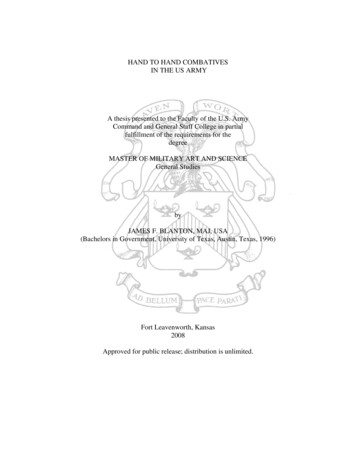
![Welcome [ shambhalamartialarts ]](/img/2/welcome-packet.jpg)

